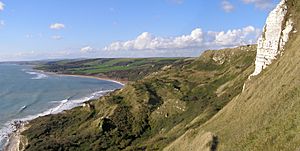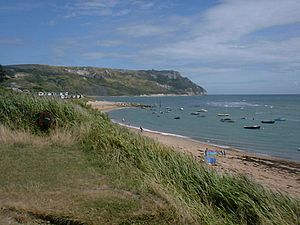White Nothe facts for kids

White Nothe (meaning "White Nose") is a cool chalk headland on the coast of Dorset, England. It's found at the eastern end of Ringstead Bay, near Weymouth. This area is super famous for its interesting rocks and old fossils. The slopes here were shaped by huge landslides long, long ago. These hard-to-reach areas are now a secret home for lots of wildlife.
White Nothe: A Coastal Wonder
A zigzag path goes up the side of White Nothe. Many people believe this path is one of the "smuggler" routes mentioned in the famous children's book Moonfleet by J. Meade Falkner. Smugglers were people who secretly brought goods into the country without paying taxes.
You can walk along the shore from Ringstead Bay to the base of White Nothe. But be careful! The path gets cut off when the tide is high. Always check the tide times before you go. At the top of the Smugglers' Path, you can see a part of the white cliff that sticks out like a nose. This is how the area got its name, "White Nose."
The National Trust owns part of White Nothe. From the top, you can see amazing views! To the east, you'll spot another chalk headland called Bat's Head. You can even walk along the clifftop path from White Nothe to famous places like Durdle Door and Lulworth Cove. If you look southwest across the sea, you might see the Isle of Portland.
Burning Cliff Mystery
Just northwest of White Nothe is a place called the Burning Cliff. In 1826, this cliff started to smoulder with an underground fire! It kept burning for several years. This happened because of a type of rock called bituminous shale, which can catch fire.
Wartime History
At the very top of White Nothe, you can find a World War II pillbox. This small, strong building was made of brick and concrete in 1940–41. It was built to help protect the coast from invaders during the war. What's special about this pillbox is that it also has a Royal Observer Corps observation post on top. This post was used by people to watch for and report enemy aircraft flying overhead.
Gallery







